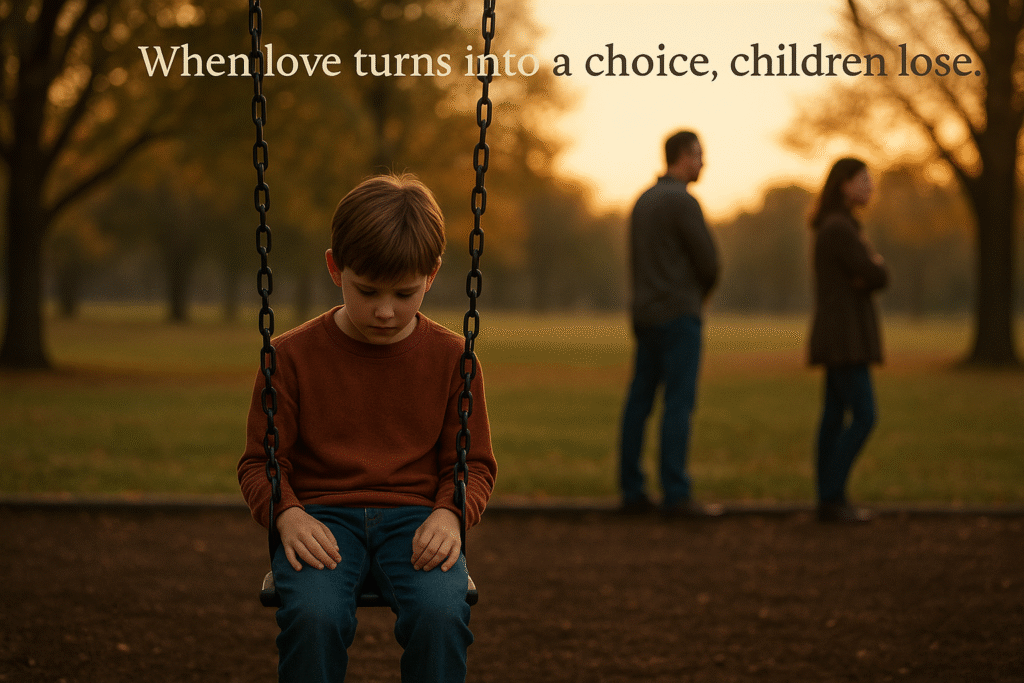🟡 Before the Disconnect Begins: What Every Parent Should Know Before a Divorce
Before we talk about parental alienation, we need to talk about something even more fundamental: how we speak to our children when a family begins to change.
Separation is never just between two adults. Children, no matter their age, will feel the shift. And how we guide them through that shift will shape what they carry long after the paperwork is signed.
If you’re approaching a divorce, one of the most important things you can do is to have an open, age-appropriate conversation with your child. Explain, as gently and clearly as possible, that while the two of you can no longer stay together as partners, your love for them remains unchanged. Avoid blaming or oversharing, but offer enough truth that they don’t have to fill in the gaps with fear or self-blame.
Let them hear it from both of you if possible. Let them ask questions. Let them be upset.
What matters most is that you stay emotionally available and consistent, especially during a time that may feel deeply uncertain for them.
The way you communicate in those early days can make the difference between a child who feels safe in both homes and a child who begins to split emotionally in order to survive the tension.
We’ll talk more about how to guide children through divorce in a separate article—because it deserves its own space.
But today, we’re going to talk about what happens when that care isn’t there.
When one parent uses emotional closeness as a weapon.
And when love is turned into a tool for control.
Let’s talk about parental alienation.
🟡 What Is Parental Alienation—And How to Recognize It
Parental alienation isn’t just a conflict between adults—it’s a distortion of a child’s relationship with one of their parents, often caused by the unresolved pain, fear, or bitterness of the other. It happens when a child is subtly—or sometimes overtly—encouraged to reject, criticize, or avoid one parent, not because of abuse or neglect, but because of the emotional messaging they receive, often from the other parent or the environment surrounding them.
It can start small. A sarcastic remark. An eye-roll. A suggestion that “your dad only cares about his new life now” or “your mom left us.” A child may be told they don’t have to visit if they don’t want to, or asked to “keep a secret” about something the other parent shouldn’t know. Over time, these small fractures accumulate, and the child, caught in the middle of pain they didn’t cause, starts to build emotional distance from the alienated parent as a way to stay loyal, safe, or accepted.
It’s important to be clear: not all rejection is alienation. If a parent has been abusive, neglectful, or inconsistent, the child’s distance might be a natural form of protection. But alienation is different—it’s not born from the child’s experience with that parent, but from the narrative they are absorbing, often without even realizing it.
Dr. Amy J.L. Baker, a leading researcher on this subject, outlines eight typical behaviors that can appear in alienated children. These include:
- Denigrating the targeted parent without specific or valid reasons
- Reflexive support for the preferred parent in every conflict
- Absence of guilt over mistreatment of the rejected parent
- Borrowed language or phrases that don’t match the child’s age or experience
Recognizing these signs early can make a significant difference. Because the longer alienation continues, the deeper the emotional divide becomes—and the harder it is for the child to reconnect with their lost parent without guilt, shame, or confusion.
🟡 The Invisible Trauma of the Rejected Parent
One of the most devastating aspects of parental alienation is that it often goes unseen, unacknowledged—even by those closest to the situation. To the outside world, it may look like a child simply choosing one parent over the other. But for the rejected parent, the experience is far more complex: it is a slow emotional erasure, a heartbreak without closure.
What makes this pain so uniquely heavy is that the child hasn’t died, hasn’t disappeared, hasn’t even said goodbye. They are still there—physically present, walking through the world—but emotionally unreachable. You see them at school events, or hear their voice on the phone, but the warmth is gone. The familiarity is gone. The connection you once built with care now feels like it’s been rewritten by someone else’s narrative.
Psychologists refer to this experience as ambiguous loss—a form of grief where the person you’re mourning is still alive, but emotionally absent or altered. There is no clear point at which it begins or ends. There’s no funeral, no support group, no socially accepted process for healing. And so the rejected parent often suffers in silence, trying to hold onto hope without knowing how—or if—it will return.
Studies show that parents who experience alienation often report symptoms of depression, anxiety, helplessness, and even post-traumatic stress. But beyond the clinical terms lies something more tender and human: the ache of loving someone who has been taught to see you as the enemy.
And still—most of these parents choose to stay. To remain emotionally available, present, and calm, even when the door is barely open. That choice takes unimaginable strength. It is a quiet kind of heroism that often goes unseen. But it matters more than the alienating parent may ever understand.
🟡 What You Can Do as the Alienated Parent
When you’re the parent being pushed away, the most instinctive reaction is often the most damaging one: trying to argue your way back into your child’s heart. You want to defend yourself, explain the lies, prove the truth. But alienation doesn’t live in logic; it lives in the emotional fog that’s been layered around your child. And that fog doesn’t lift through confrontation. It lifts through consistency, safety, and time.
So what can you do, when you’re being unfairly rejected?
1. Stay steady.
Your child may seem cold, distant, even cruel. But underneath that surface is confusion, loyalty conflict, and a desperate need to feel safe. Be the calm in the storm, even when you feel shattered inside. Emotional steadiness builds trust, and trust—over time—can reopen doors.
2. Avoid criticizing the other parent.
Even if you know what they’re doing is manipulative or unjust, resist the urge to “set the record straight” by tearing them down. Children often experience this as an attack on part of themselves. Instead, model integrity. Let your actions show your love and reliability, without needing to discredit anyone.
3. Be present without pressure.
Show up. Not with demands, not with guilt, not with desperate attempts to reconnect—but with calm, grounded presence. As psychiatrist Dr. Daniel Amen suggests, even 20 minutes of undivided, non-directive time a day—without questions, commands, or corrections—can be enough to reestablish connection. This time doesn’t have to be perfect. It just needs to be real.
4. Validate your child’s feelings without feeding the false story.
You can say, “I hear that you’re angry,” or “It sounds like you’re feeling hurt.” But you don’t have to accept harmful falsehoods in order to connect. Stay anchored in your truth, but allow space for your child to process their experience without shame.
5. Care for yourself.
This is not just a crisis in your relationship with your child—it’s a trauma in your inner world. Seek out support. Therapy, community, somatic work—whatever helps you stay emotionally regulated. Because alienation can hollow a person from the inside, and the only way to keep showing up with love is to protect the small flame of your own emotional well-being.
🟡 What to Say to Your Child (and What Not to Say)
When your child begins to reject you, it’s natural to want to explain, defend, or plead. You want them to know the “real story.” But what they need even more than information—is safety. The kind of emotional safety that says, You don’t have to choose. You are allowed to love both of us.
Instead of fighting the narrative, focus on the connection. Let your words be simple, true, and free of blame.
Here are a few phrases that can begin to gently reopen the door:
- “You don’t have to agree with me. I just want you to know I’ll always be here.”
- “I’m sorry things feel confusing right now. What happened between your parents is not your fault.”
- “I know you might be angry. I’m still your parent. And I still love you—no matter what.”
And perhaps most importantly:
“You don’t have to protect me, fix this, or take sides. You just get to be a kid. And I’ll keep showing up for you, even from the distance.”
The goal isn’t to convince them—it’s to remain available, emotionally consistent, and lovingly human. That is what endures, even when words fail.
🟡 Closing Thoughts: A Way Back to Each Other
Parental alienation may be one of the quietest forms of emotional violence a child can experience. It asks them to split their heart, to question their instincts, to carry blame for something they didn’t break. And it asks a parent to keep loving in the face of rejection that feels unbearable.
But here’s what I’ve learned: love that is offered with steadiness—even when it’s not returned right away—plants seeds. Seeds that may take months or years to grow. But they do grow.
The best thing you can do is become the parent your child can come back to. Not the one who punished their confusion, but the one who waited with patience and truth.
And if you’re reading this while preparing for divorce, let this article be a gentle warning and a call to consciousness: alienation can begin with the smallest of unspoken resentments. What protects your child most is not a perfect divorce—but your commitment to never make them choose between their two safe places.
In the end, your calm presence may be the thing that helps your child find their way back to you.
🖋 This article is part of a larger project on conscious parenting through divorce and emotional rupture. A comprehensive book on Parental Alienation is now available in both printable and digital versions.



